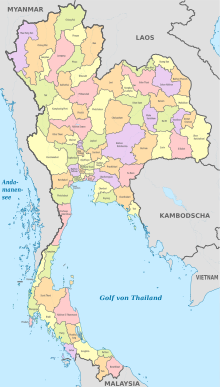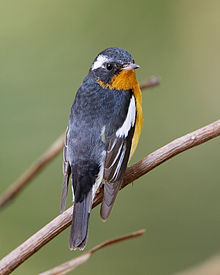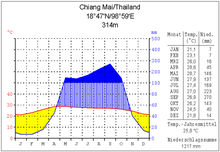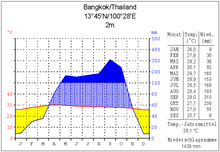Thailand
![]()
This article is about the state; for the film from the series Das Traumschiff see Das Traumschiff: Thailand.
Template:Infobox State/Maintenance/TRANSCRIPTION
Template:Infobox State/Maintenance/NAME-German
Thailand (Thai ประเทศไทย [pratʰêːt tʰaj]), officially Kingdom of Thailand (![]() [râːt͡ɕʰáʔaːnaːt͡ɕàk tʰaj], colloquially
[râːt͡ɕʰáʔaːnaːt͡ɕàk tʰaj], colloquially ![]() [mɯːaŋ tʰaj]), is a state in Southeast Asia. It borders Myanmar, Laos, Cambodia, Malaysia, the Andaman Sea (part of the Indian Ocean), and the Gulf of Thailand (part of the Pacific Ocean). The capital of Thailand and by far the largest city in the country is Bangkok. The country is a de jure constitutional monarchy. King Bhumibol Adulyadej was head of state from 1946 until his death in 2016. Since 1 December 2016, his son Maha Vajiralongkorn is Thai king.
[mɯːaŋ tʰaj]), is a state in Southeast Asia. It borders Myanmar, Laos, Cambodia, Malaysia, the Andaman Sea (part of the Indian Ocean), and the Gulf of Thailand (part of the Pacific Ocean). The capital of Thailand and by far the largest city in the country is Bangkok. The country is a de jure constitutional monarchy. King Bhumibol Adulyadej was head of state from 1946 until his death in 2016. Since 1 December 2016, his son Maha Vajiralongkorn is Thai king.
Until 1939, the country, which was roughly on the territory of the present state, was called Siam. The approximately 69 million inhabitants are 75% ethnic Thai and 14% Chinese; in the three southernmost provinces live predominantly Malays. Buddhism is the dominant religion, almost 94% of Thais profess it, it is particularly promoted by the state, but is not an official state religion; 5.1% are Muslims.
Thailand is a middle-income emerging economy that is classified by the United Nations Development Programme as a country with high human development. The country has been able to significantly reduce poverty in recent decades. It has benefited from the consumption of a growing middle class and increasing integration into world trade. Thailand's main source of revenue, however, is tourism. In 2017, 35 million tourists visited the country. Its capital Bangkok was the most visited city in the world in 2016.
Geography
→ Main article: Geography of Thailand
The territory of Thailand occupies a considerable part of the land area of Southeast Asia and extends southeast of the last foothills of the Himalayas to the Malay Peninsula, enclosing the Gulf of Thailand, a marginal sea of the South China Sea. The land area of Thailand is remotely reminiscent of the head of an elephant. The maximum extension in north-south direction is 1770 kilometers, in east-west direction 780. The border is altogether 5326 kilometers long. The coastline is 1878 kilometers long in the Gulf of Thailand and 937 kilometers long in the Andaman Sea. Thailand has a total area of 513,115 km². Thailand is located between 5° 37' and 20° 27' north latitude and between 97° 22' and 105° 37' east longitude.
The northern region is mountainous, there you can find the highest point of the country: Doi Inthanon (2565 m). The northeast (Isan) consists of the Khorat plateau, a dust-dry landscape in summer and flooded in the rainy season, which does not allow intensive agriculture. Irrigation projects and dams are intended to remedy this situation. The population there is poorer than the average for the country. In the north and east of Isan, the Mekong River forms the border with Laos.
The central region is dominated by the Mae Nam Chao Phraya (Chao Phraya River), which supplies water to the fertile land and flows into the Gulf of Thailand south of Bangkok. The eastern region is agricultural and lies on the Gulf of Thailand. The beautiful beaches and offshore islands led to increased tourism. The Central Plain and the Eastern Seaboard are the economic heart of the country. The southern region lies on the elongated Malay Peninsula, which separates the Pacific Ocean from the Indian Ocean. The Isthmus of Kra forms the narrowest point between the two seas and is only 64 km wide. Therefore, it is also known as the "thin neck" in Thailand. Mountain landscapes (in the northern part the Tenasserim Mountains on the border with Myanmar, in the far south the Sankalakhiri Mountains on the border with Malaysia), rainforest and dream beaches alternate.
Larger cities besides the capital Bangkok are: Chiang Mai, Nonthaburi, Samut Prakan, Nakhon Ratchasima (formerly Khorat), Khon Kaen and Chon Buri.
Thailand is divided into six regions with 76 provinces; the names of the provinces and their capitals are identical. The six Thai regions are:
- Northern Thailand with provinces like Chiang Mai and Chiang Rai
- Northeast Thailand (also known as Isan) with provinces like Khon Kaen and Nakhon Ratchasima
- Central Thailand with provinces such as Bangkok, whose capital is also the capital of all Thailand, and Phra Nakhon Si Ayutthaya
- Eastern Thailand with provinces like Chon Buri and Trat (here are the seaside resort Pattaya and islands like Ko Chang and Ko Samet)
- Western Thailand with provinces like Kanchanaburi with the Bridge on the River Kwai and Phetchaburi with Cha-am
- Southern Thailand with provinces like Phuket and Surat Thani with the island Ko Samui
See also: Islands to Thailand
Waters
More than two thirds of the territory of Thailand is drained by two river systems. These are the Mae Nam Chao Phraya with its tributaries Mae Nam Ping, Mae Nam Yom, Mae Nam Nan and Mae Nam Wang as well as the Mekong with its tributaries Mae Nam Mun, Mae Nam Chi and Mae Nam Ing. In the mountainous north of Thailand the drainage areas of these two rivers intertwine very strongly, in central Thailand the Phetchabun Mountains form the watershed.
The water flow of both river systems is subject to strong seasonal fluctuations in each case. Their lower reaches are characterized by a very low gradient, which leads to frequent flooding, sediment deposition and shifting of the river courses. Both rivers are regulated by numerous dams and lakes, and intensive rice cultivation is practiced on their banks.
In the south of Thailand there are only short rivers, worth mentioning are Tapi, Phum Duang and Pattani. They regularly flood during the northeast monsoon, i.e. in winter.
Important lakes are Songkhla Lake, Nong Han, Phayao Lake and Bueng Boraphet.
Climate
The climate is tropical-monsoonal. Average annual temperatures range from 28 °C in the south to 19 °C at Doi Inthanon, Thailand's coolest point in the far north. Seasonal variation is slight everywhere; while three seasons can be identified in the north (relatively cool between November and February, very hot with temperatures well over 35 °C from March to May, and hot from May to November), in the south temperatures are about the same all year round. Daily amplitudes range from 6 °C to 10 °C in the south and in the humid season in the north; in the dry season of the north, the daily amplitude ranges from 9 °C to 19 °C.
The monsoon winds have different regional effects: The winter northeast monsoon brings continental air and causes dryness in northern Thailand, while the air over the Gulf of Thailand accumulates moisture and causes rain in southern Thailand. The summer southwest monsoon generally brings moist air masses and causes rainfall throughout the country. The south thus knows 8 to 11 humid months per year, while the northeast only gets four and a half to five and a half humid months.
Sporadically and with much lower frequency than in the neighbouring countries, tropical cyclones occur in Thailand, coming from the South China Sea and the Gulf of Thailand and hitting the Thai mainland.
Geomorphology
The area of present-day Thailand was covered by a shallow sea between the Paleozoic and the Upper Jurassic. The first north-south folding occurred in the same epoch. Between the Mesozoic and Middle Tertiary, intense weathering of the surface took place with little tectonic activity. The result is sandstone mountains with mesas and tower karst landscapes. In the latest epoch, beginning with the young Tertiary, the collision of the Indo-Australian plate with the Eurasian-Chinese mainland began. Folding and uplift occurred with the simultaneous development of north-south trending mountain ranges with notch valley reliefs and intramontane plains. The uplift plains formed since then by sedimentary deposition are important for settlement.
They are dominated by fluvisols, which are intensively used for wet rice cultivation and have therefore largely been converted into anthrosols. Ferralsols, plinthosols and acrisols are found on the rump areas, which are no longer productive just a few years after being cleared. On slopes, acrisols and cambisols predominate, which are very prone to erosion.
Flora
Thailand's natural vegetation consists of forest; as recently as 1960, forest cover was reported to be 75 to 80 percent. This value has fallen to 18 to 26 percent today, depending on the source, due to strong population growth, measures to increase the quality of life and strategic road construction and the associated colonisation in eastern Thailand during the Vietnam War.
Southern and western Thailand are dominated by species-rich tropical rainforests, which are little used economically precisely because of their high biodiversity. However, they have a high potential, for example for pharmaceutical companies. Plant species that are used are the wood-oil tree and fruit trees such as the durian. Species-rich forests with a certain proportion of deciduous species are also prevalent in the mountain areas; pine forests, oak species and chestnut trees also occur locally. In those regions with seasonal drought, deciduous forests predominate. The most important tree species for humans in these forests is the teak tree; it is often cultivated in plantations for export purposes. Economically interesting, but ecologically problematic, are plantations of eucalyptus species, which are not originally native to Thailand. After clearing these forests, secondary vegetation dominated by bamboo species and silver hair grass (Imperata cylindrica) settles.
The mangrove forests that thrive in the coastal waters of Thailand are species-poor and consist mainly of Rhizophora species. The nipa palm, which is found in the mangroves, is used by humans.
Fauna
The fauna of Thailand is part of the Oriental faunal region. Even today, the country is home to numerous large mammals, such as Asian elephants, tigers, leopards, clouded leopards, sambar deer, muntjaks, wild cattle such as gaurs and bantengs, wild boars and various species of monkeys (especially gibbons). Some wild water buffalo apparently still live on the border with Myanmar, and shabra tapirs in southern Thailand. Other species, such as the Sumatran rhinoceros, the Java rhinoceros and the lyrebird, are probably extinct. Particular species richness is found among Thailand's lizards and snakes, including various pythons as well as king cobra and spectacled snake. Many species of amphibians, toads and frogs enrich the fauna of Thailand. In addition, more than 1200 species of day and night moths and over 10,000 species of beetles have been counted.
Birds occur in large numbers in the forests of Thailand (here especially nectar birds, parrots, pheasants, wild peacocks, beos and hornbills). The cultivated landscapes are populated by storks, ibises, herons, cranes and pigeons, such as green pigeons.
In the inland waters of Thailand, the carp fish are important, they play a major role especially for human nutrition. The coastal waters are rich in plankton and have rich stocks of herring and mackerel, furthermore sharks of various species occur. Other aquatic species found in Thailand are crocodiles, especially the inguinal crocodile, the now almost extinct Siamese crocodile, the Sunda gavial (probably already extinct) and various species of turtles, the loggerhead turtle and land turtles.
Over 60,000 km² of land area and more than 6000 km² of marine area and islands are designated as national parks, wildlife sanctuaries or marine parks, see National Parks in Thailand. The best-known protected areas include the Khao-Yai National Park and the Thung Yai and Huai Kha Khaeng wildlife reserves, the latter belonging to the Western Forest Complex system of protected areas.
Management structure
→ Main article: Administrative divisions of Thailand and List of provinces of Thailand.
Thailand is a unitary state. The current administrative division took place in 1897 under King Rama V (Chulalongkorn). Numerous provinces have been changed or created since then. In 2008, there were in Thailand:
- 76 Changwat (จังหวัด - 'provinces'), with each province named after its capital,
- 877 Amphoe (อำเภอ - 'districts' or 'counties'),
- 7,255 Tambon (ตำบล - 'sub-districts' or 'communities'),
- 74,944 Muban (หมู่บ้าน - 'village communities' or 'villages').
These units form the hierarchical and centralised system of provincial administration, which primarily serves to implement the central government's guidelines uniformly throughout the country. In addition, there is also the system of local government, whose units are more independent and in which the inhabitants have greater opportunities for co-determination. It has become increasingly important since the 1990s as part of the decentralisation process. It consists (as of 2013) of:
- 76 provincial administrative organizations (Thai องค์การบริหารส่วนจังหวัด, short อบจ. - Ongkan Borihan suan Changwat), whose areas of responsibility are congruent with the provinces,
- 2,283 Thesaban (เทศบาล - 'municipalities'), including.
- 30 Thesaban Nakhon (เทศบาลนคร - 'metropolitan municipalities').
- 172 Thesaban Mueang (เทศบาลเมือง - 'city-municipalities')
- 2,081 Thesaban Tambon (เทศบาลตำบล - 'small town municipalities').
- 5,492 Tambon Administrative Organizations (องค์การบริหารส่วนตำบล, short อบต. - Ongkan Borihan suan Tambon), for the rural communities that do not belong to any Thesaban.
In addition, there are two special administrative units: Bangkok, the national capital, and Pattaya, an internationally known seaside resort. Bangkok is on a par with the provinces and is therefore sometimes counted as a province. The city is divided into
- Khet (Thai: เขต, this corresponds to the amphoe of the provinces) and
- Khwaeng (Thai: แขวง, this corresponds to the provincial tambon).
The assignment of provinces to larger regions is inconsistent, so sometimes a province may be assigned to one region, sometimes to a neighboring region.
Cities
In 2016, 51.5 percent of the population lived in cities or urban areas. By far the largest city in Thailand is Bangkok. The Bangkok metropolitan region is home to nearly 16 million people, while the city itself has 5.6 million inhabitants. The largest cities are (as of 2017):
- Bangkok (Krung Thep): 5,686,646 inhabitants
- Nonthaburi: 255,793 inhabitants
- Pak Kret: 189,258 inhabitants
- Hat Yai: 159,627 inhabitants
- Nakhon Ratchasima: 131,286 inhabitants
- Udon Thani: 131,192 inhabitants
- Chiang Mai: 131,091 inhabitants
- Surat Thani: 130,114 inhabitants
See also: List of cities in Thailand

Imágenes principales Provinces of Thailand

Mugimaki Flycatcher in Khao Yai National Park

Dipterocarpus alatus

Wild elephants in Khao Yai National Park

Climate diagram Chiang Mai

Climate diagram Bangkok

Climate diagram Phuket
Questions and Answers
Q: What is the name of Thailand's current head of state?
A: The current head of state of Thailand is King Vajiralongkorn.
Q: What are the neighboring countries to Thailand?
A: The neighboring countries to Thailand are Laos, Cambodia, Malaysia, and Myanmar.
Q: What was the former name of Thailand?
A: The former name of Thailand was Siam until June 1939 and between 1945 and May 11 1949.
Q: What is the main religion practiced in Thailand?
A: Buddhism is the main religion practiced in Thailand; 95% follow this philosophy.
Q: Are there any other religions practiced in Thailand besides Buddhism?
A: Yes, there are other religions practiced in Thailand besides Buddhism such as Christianity, Hinduism, Islam, and Sikhism.
Q: Why have some Muslims in the south begun fighting against the government?
A: Some Muslims in the south have begun fighting against the government because they want to be more independent.
Q: What is the total fertility rate for 2019 in Thailand?
A: The total fertility rate for 2019 in Thailand was 1.3.
Search within the encyclopedia